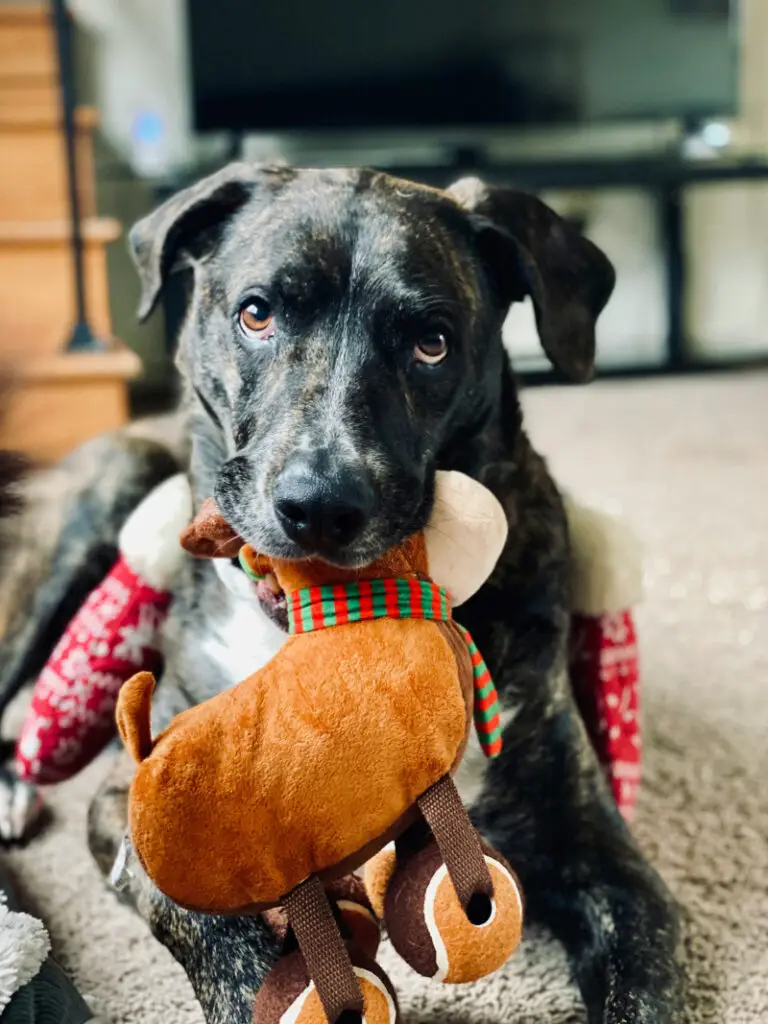Unfortunately, poisoning in dogs is a fairly common occurrence. It is known that many of the items and substances that we use on a daily basis, including food and medicine, can be really dangerous for these animals.
Are you aware of everything that can be poison for dogs? Does your pet live in a safe environment? Here is a compilation of the 9 most common types of poison, the symptoms to consider in case of canine poisoning, the best prevention measures… and much more.
Table of Contents
Things that are poison for your dog
You may be surprised to learn that some of the most dangerous poisons for dogs are foods, medications, and items that we humans use on a daily basis. Here are included:
- Certain over-the-counter medications and supplements
- Certain prescription drugs
- Human food
- Household chemicals and cleaning products
- Insecticides and rodent poisons
- Some ornamental plants
Let’s take a closer look at each of these groups…
1. Over-the-counter medications
Such common medications as acetaminophen (Paracetamol, Tylenol) and nonsteroidal anti-inflammatory drugs, such as ibuprofen (Advil) and naproxen (Aleve), can be harmful to dogs. Even swallowing just 2 pills can cause symptoms of poisoning.
In case of ingestion of NSAID drugs, the dog can develop kidney failure, as well as severe stomach and intestinal ulcers; this is usually more likely if the dog is small. Warning signs to watch out for are:
- Fever
- Diarrhea
- Dehydration
- Abdominal pain
- Slow behavior
- Loss of appetite
- Vomiting (sometimes with blood)
- Loss of bladder control
- Pale mucous membranes
- Abnormally fast heartbeat
In dogs, medications like ibuprofen are recycled back and forth in the body through the liver, rather than being eliminated. That recycling process causes repeated exposure to the drug and is responsible for the symptoms of poisoning.
For its part, the ingestion of acetaminophen can lead to liver failure and damage to red blood cells when consumed in large doses. Here are the most common poisoning symptoms:
- Brownish-gray gums
- Difficulty breathing
- Swelling of the face, neck, or extremities
- Drop in body temperature
- Vomiting
- Jaundice (yellowing of the skin and whites of the eyes)
- Eat
2. Prescription drugs
In humans, these drugs help save lives, but in dogs, they almost always have the opposite effect. Even small doses can be fatal.
Different animal poison control centers recommend keeping dogs away from the following drugs:
- Antidepressants. Overdoses can lead to serious neurological problems, including sedation, lack of coordination, tremors, and seizures. Some antidepressants also have a stimulant effect, causing a dangerous increase in heart rate, blood pressure, and body temperature.
- Medications to treat Attention Deficit Disorder / Attention Deficit Hyperactivity Disorder. Because they contain powerful stimulants such as amphetamines and methylphenidate, even minimal ingestion in dogs can cause tremors, seizures, elevated body temperatures, and life-threatening heart problems.
- Medications against insomnia and anxiety. Dogs often experience the opposite effect to humans; that is, they are agitated instead of sedated. These medications can cause severe lethargy, incoordination, and slowed breathing in pets.
- Birth control pills. Birth control pills often come in packages that are very conspicuous to dogs. Fortunately, small doses are not that dangerous, but when ingested in large amounts, the dog can show signs of poisoning.
- Blood pressure medications. They can cause serious poisoning, even when the pet has only ingested a small amount. Overdose can result in a life-threatening drop in blood pressure and a very slow heart rate.
- Medications to treat diabetes, cancer, muscle relaxants, and vitamin D derivatives can also be toxic.
See later:
- Does your dog have vomiting? Common Causes, Types, and How to Tell Them Apart
- Why Does My Dog Have Diarrhea and Vomiting? What I can do?
3. Human food
As an owner, there is something very important that you should know: dogs have a different metabolism than people. Many of the foods that are completely safe, and even beneficial to us, can be fatal to our pets.
These are the most poisonous foods, drinks, and ingredients for dogs:
Avocado parts
Avocados contain a fungal toxin called persin, which acts as a poison in these and other animals. Two typical symptoms are vomiting and diarrhea.
The highest concentrations of persin are found in the bone, skin, and leaves of the plant, so all of these parts are potentially toxic to your dog. Another big concern about dogs and avocados is the seed, which could cause them to choke.
In addition, some dogs are known to be sensitive to the high-fat content of avocados and can develop pancreatitis, even if they have only eaten a small amount of the pulp.
All about the topic in: Can Dogs Eat Avocado? Consumption and Risks
Chocolate
Although not harmful to humans, chocolate does contain theobromine and caffeine, two substances that are toxic to dogs. In small doses, they may only cause vomiting, but the pet can die of poisoning if he eats large amounts of chocolate.
This usually depends on the type of chocolate and the size of the dog. For one thing, dark chocolate is known to contain more theobromine and caffeine than milk chocolate and white chocolate. In addition, small breed dogs can die from eating as little as a half-ounce of chocolate, while a large dog could survive on 4 to 8 ounces.
In general, these are the symptoms that a dog poisoned by eating chocolate can show:
- Vomiting
- Diarrhea
- Increased body temperature
- Muscular stiffness
- Fast breathing
- Incrise of cardiac frecuency
- Low blood pressure
- Seizures
- Severe symptoms (heart failure, weakness, and coma)
It may interest you: Brown Vomit in Dogs – Why Does My Dog Vomiting Brown?
What is the worst chocolate for dogs?
Baking chocolate appears to be the most dangerous type of chocolate, as it has the highest concentration of caffeine and theobromine. As little as 1 ounce of this chocolate can be toxic to a 20-pound dog.
Alcohol
Alcohol poisoning in dogs is not such a common event because, in most cases, the taste is unpleasant. But that doesn’t mean we shouldn’t pay attention. Severe symptoms of alcohol poisoning in dogs include vomiting, breathing problems, coma, and in severe cases, death.
Which is worse for dogs: alcohol or beer and wine?
Drinking light beers is said to be the least dangerous scenario, as their alcohol content is low. These are followed by craft beers, wine, hard liquor, and finally alcohol.
However, when it comes to dogs or any other pet, the most worrying thing is always the amount, and not so much the drink that has been ingested.
Note: Keep in mind that your dog may be exposed to certain hidden sources of alcohol, such as flavorings, essential oils, mouthwash, cleaning products, etc.
Macadamia nuts
When talking about foods that can be poisonous to dogs, it is necessary to mention these nuts. Although researchers don’t know for sure what causes this effect, it is cautioned that dogs should never eat macadamia nuts.
The most common sign of poisoning is weakness, especially in the hind legs. Other symptoms include lethargy, diarrhea, vomiting, tremors, and fever.
Some cases may be mild, show few symptoms, and resolve within several days. However, severe cases can involve constant shaking, a high fever, and an inability to walk. If you suspect your dog has eaten even a small amount of macadamia nuts, see your vet immediately.
Grapes and raisins
Without a doubt, another of the most common dog poisons that we usually have at home.
The toxicity of grapes and raisins in dogs is well documented. Although the exact substance that causes this toxic reaction is not yet known, it is clear that dogs should not eat them; in fact, they shouldn’t even taste them. Even small amounts can be fatal to your pet.
Grape or raisin poisoning will cause the dog to develop a combination of symptoms, including vomiting and/or diarrhea, loss of appetite, lethargy, weakness, abdominal pain, tremors, and seizures, among others.
Are all types of grapes and raisins poisonous to dogs?
Yes. Poisoning can occur with the ingestion of red and green grapes, with and without seeds, organic and non-organic, etc. Foods containing grapes and raisins, such as cereals, trail mix, granola, and baked goods, are also potential sources of toxicity.
All the details in: Can a Dog Eat Grapes Safely? Risks, Signs, Portion
Xylitol
Extremely toxic to dogs, this sweetener is found in many common products and foods. Although xylitol offers benefits for people, non-primate species, such as dogs, do not suffer the same fate.
When a dog eats something that contains xylitol, it is quickly absorbed into the bloodstream, resulting in a powerful release of insulin from the pancreas. Consequently, insulin causes a sudden and significant drop in blood sugar levels (hypoglycemia).
If not treated promptly, this condition can be fatal. The animal may show weakness, convulsions, and even experience liver failure.
What foods contain xylitol?
According to an FDA publication, xylitol is a common ingredient in chewing gum, sugar-free candies and desserts, chocolate bars, light ice cream, breath mints, baked goods, cough syrups, chewable vitamins, mouthwashes, toothpaste, some butter peanuts, and other tree nuts, over-the-counter medications, dietary supplements, etc.
It may interest you:
- What Vegetables Can Dogs Eat? Which ones are prohibited?
- Can Dogs Eat Liver? Types, Recipes, and Contraindications
4. Veterinary products
This includes certain medications, as well as flea and tick treatments. Contrary to what many may imagine, cases of canine poisoning by veterinary drugs are not uncommon. Some of the most problematic medications in this regard are pain relievers and dewormers.
Yes, unfortunately, the application of commercial products to combat fleas and ticks results in numerous cases of animal poisoning. This is usually due to accidental ingestion by the dog, or from the application of an excessive amount in small dogs.
It may interest you:
- Looking for a Home Remedy for Fleas? 15+ Homemade Fleas (Dogs, Cats, House)
- How to Remove Ticks on Dogs Fast? Easy Method + Remedies
5. Household products
Exposure to bleach, disinfectants, and other household cleaning chemicals can not only be harmful to people but is also a common cause of poisoning in pets. Dogs specifically often experience stomach and respiratory tract problems.
Keep sprays, detergents, polishes, bleaches, stain removers, rust removers, toilet bowl cleaners, drain cleaners, and window cleaners out of your dog’s reach.
But these are not the only potential dangers. Chemicals contained in antifreeze, brake fluids, paint thinners, fuels, and pool chemicals are known to also act as a poison for dogs, causing stomach upset, depression, chemical burns, kidney failure, and in severe cases, death.
Dogs seem to love the smell and sweet taste of antifreeze products, which is why they are one of the main causes of chemical poisoning in these animals.
6. Fertilizers
Since fertilizers are usually a combination of ingredients, the effects of their ingestion on dogs can vary. They typically cause mild to moderate gastrointestinal irritation, which may be accompanied by vomiting, diarrhea, excessive drooling, and abdominal pain. Symptoms can be more severe if the animal ingests a large amount.
7. Rat Poisons
Unfortunately, many baits used to attract and kill rodents can also attract the attention of our pets.
The symptoms of poisoning will depend on the nature of the poison, and may not appear until several days after consumption. In cases of significant ingestion, the dog may experience vomiting, bloating, internal bleeding, brain swelling, and kidney failure.
It should be noted that rodent poisons have the potential for transmission toxicity, meaning that pets can be poisoned by eating dead rodents that were previously poisoned.
8. Insecticides
Agricultural, lawn, and garden insecticides are also toxic to pets. Many dogs may not exhibit the classic signs of poisoning when exposed to these chemicals, but you will usually be able to tell that the animal is unwell.
Symptoms associated with insecticide poisoning include fever, vomiting, loss of appetite, depression, muscle tremors, increased heart rate, and breathing problems.
9. Ornamental plants
Did you know that many of the plants that we usually have in gardens, balconies, and terraces can be extremely poisonous for dogs and cats?
These pets are known to often be tempted to chew on the odd leaf, which can result in adverse symptoms ranging from mild, such as drooling and vomiting, to severe, including increased heart rate, seizures, coma, and even death.
The American Society for the Prevention of Cruelty to Animals (ASPCA) offers an extensive list of all plants that are considered poisonous to dogs. These include:
- Azaleas and rhododendrons (vomiting, diarrhea, coma, death)
- Tulips and daffodils (serious stomach problems, shortness of breath, increased heart rate)
- Sago palm (vomiting, seizures, liver failure)
- Clover or cruet (tremors, drooling, kidney failure)
- Jade Tree (nausea, retching)
- Hydrangeas (vomiting, diarrhea, depression)
Useful tips to prevent poisoning in dogs
The best way to prevent this risk is to avoid exposing your dog to dangerous substances. Consider the following suggestions:
- Keep all medications in cabinets that are inaccessible to the dog, even those that come in child-resistant bottles. If you accidentally drop a pill on the floor, be sure to look for it right away.
- Supervise anyone who may need help taking their medications, especially the elderly.
- Avoid sharing your food with your pet, especially if it contains any of the toxic foods or ingredients mentioned in this article.
- Follow the instructions for use offered by the manufacturer or the veterinarian to the letter when applying products to kill fleas and ticks.
- Be sure to store rodent poisons in metal cabinets or on shelves where your pet can’t get to them.
- Remember that dogs can also be poisoned by eating an exposed rodent.
- Choose ornamental plants that do not pose a danger if your dog chews on them. If you have any toxic plants in your home, make sure you keep them out of their reach.
- Store all chemicals and cleaning products in areas inaccessible to the dog.



